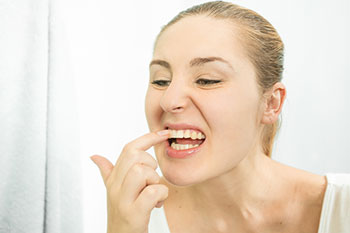
A food trap can occur between two teeth that have a slightly loose or open area of contact. An opening or space between teeth allows food to become trapped while eating. Sometimes the food trap can be noticeable and annoying. Or it may go completely unnoticed, depending on the size and severity. Some food traps pose a risk to the health of the teeth and gums in the area if not addressed.
How Can Food Traps Affect Teeth and Gums?
If food particles are consistently building up between teeth in a certain area, there is more bacterial accumulation. Bacteria poses an increased risk for cavities and gum disease. The body will send more blood to the area (which contains white blood cells) to fight off the bacteria. There will be swelling and bleeding in the area, and if left untreated, the gum, ligament and bone support may recede away.
What Can Be Done?
Thankfully, the solution is quite simple. An open contact or gap must be closed to prevent food from becoming trapped between the teeth. This can be achieved in a couple of different ways. Please talk with your dentist about your preferences and their recommendations for which treatment option will work best for you.
Treatment Options
Dental Filling
A dental filling can be placed on either one or both of the teeth to form a contact between the teeth without space. The contact should still allow floss to slide between without tearing or shredding.
Dental Crown
A dental crown can be placed on one or both of the teeth to change the shape of the teeth and close the contact. This option is for more severe food traps that are unable to be fixed with just a filling.
Possibly Leave It
Lastly, mild food traps, if cleaned adequately at home, are ok to leave and monitor. If the food trap is easy to clean out, and you have the right tools to use at home, the food trap may not pose as much risk to the teeth and gums. If left, your dentist and dental hygienist will monitor the food trap at each dental appointment.
